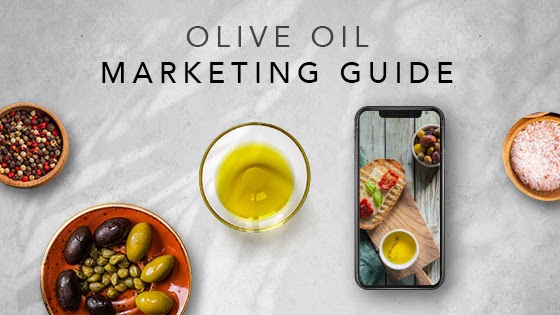Olive oil has been a staple in the kitchen cabinet for years now, and as health consciousness grows, the demand grows as well. The industry is steeped in competition, so to help you best market your olive oil business, we’ve written this guide with helpful tips & suggestions.
Understanding the Olive Oil Market
Olive oil production is a $90.8 million industry in the US. The demand for olive oil has grown consistently over the past decade; there are a lot of people buying, but there’s a lot of people selling.
It’s always important to know the seasonality of the product you sell. With olive oil, however, sales maintain consistency year-round. Below is a graph from Google Trends showing the online interest in olive oil over the past year:
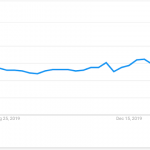
As commonplace as olive oil is, this chart may not come as a surprise. The reasons to purchase olive oil may be few: primarily for cooking and for its health benefits. However, the reasons people will buy one bottle of olive oil over another are vast:
- Price: Many people want the best value olive oil, and are often willing to skimp on quality if they plan only to cook the oil down.
- Quality: Especially when customers make dishes where the olive oil’s flavor is bold, taste-quality is something they look for. Moreover, there’s a growing preference for organic products and for various seals of approval on olive oil bottles.
- Origins: Olive oil is largely-imported to the US, and consumers have existing opinions about the olive oils of different regions, production methods, and traditions. Highlighting the unique background of your olive oil can be a strong differentiator.
- Ingredients: Whether your olive oil product contains some other oils or something distinctive like seaweed or green chili, these are reasons a customer might choose or avoid your bottle. How you incorporate ingredients and the crafting process of your olive oil are 2 key aspects for many consumers.
What Makes Your Olive Oil Business Unique?
It may be the case that your olive oil is a price leader in the market. You may lead in quality, perhaps having the most proprietary sourcing methods. These are powerful aspects that set you apart from competitors, and your customers ought to know what sets you apart.
Positioning your brand as unique is critical in such a competitive industry, and the best way to do so is with a narrative.

Telling your brand’s story can let customers know the origins of your olive oil, how it’s made, and what the ingredients add to the product. It’s the perfect way to show how your bottle of olive oil is a unique product that’s worth the price tag, whatever it may be.
Of course, a story is more than just facts and data. A story is personal. A story helps your customer see how meaningful your product is to your business — that it’s more than just a source of revenue.
When your customers see your love for your product, it’s more likely that they grow attached to your product as well.
Olive Oil Business Marketing: Aesthetics of Your Brand
Every successful olive oil brand has a noticeable aesthetic. You see it in brand messaging, in the packaging and the labels on their bottles, and in their online presence.
Your brand should have a conception or goal for its aesthetic, and you should build it up with complementary packaging.
Eye-Catching Olive Oil Bottle Design
The packaging is the first thing that customers see on the shelf, and it’s no secret that first impressions are everything.
It’s without a doubt that the perception of ‘high quality’ begins with the container. That’s where glass beats plastic. A durable glass bottle is an important part of your marketing strategy. To market your olive oil as top-notch, you want a glass bottle that gives the right impression.
Our top recycled glass bottles for olive oil come in multiple styles and sizes:
| Bottle Image | Bottle Name | Capacity | Description | Color Options |
|---|---|---|---|---|
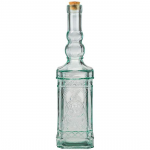 | Ornate Recycled Glass Bottle | 23.7 oz | This glass bottle looks incredible in the kitchen cabinet. Intricately designed and patterned, when it’s full of oil — saying it’s eye-catching is an understatement. | Clear, Cobalt Blue |
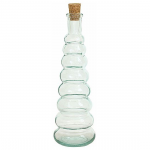 | "O" Recycled Glass Bottle | 13.5 oz | The attention-grabbing design aside, this glass bottle was meant to pour with its unique ripples throughout. | Clear |
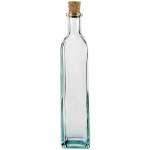 | Rectangle Recycled Glass Bottle With Cork | 12.7 oz | Many times, simple is better. This 100% recycled glass bottle is the epitome of an olive oil bottle. | Clear, Lime Green, Red, Aqua, Cobalt Blue, Violet |
Picking the Right Colors for Your Olive Oil Bottle
When you’re designing your olive oil packaging, picking the best colors is essential.
Most customers like to see the color of the products they buy, so clear bottles are suggested. Still, colored, see-through glass bottles can work great also.
Greens and greys give a traditional look, while brighter or matted colors can seem more modern. Take a look at the Glassnow custom color options if you have a specific color in mind. What’s most important is that the visual aesthetic of your bottle matches the aesthetic of your brand.
Labeling Your Olive Oil Bottle
For many olive oils, the brand’s story is written on the label. With modern packaging trends preferring few words on the label, olive oil is a rare exception.
Obviously, there is no one optimal design. In short, the label should match the bottle to give a straightforward design that matches your brand’s message.
Few Top Examples of Olive Oil Bottles and Label Designs
Oftentimes, to be the best, you have to learn from the best. Here below we show 3 of the best-executed olive oil packaging designs.
Olio Verde
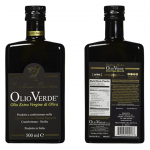
Olio Verde does break the traditional guide to making your oil visible — but in the best of ways. Everything about this glass packaging screams premium.
The well-written details of the Sicilian olive farm on the back, the centered text, and simple text on the front of the bottle — everything here works to sell.
Grand’Aroma
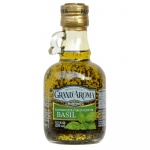
Grand’ Aroma shows us that olive oil bottles truly can branch out from the traditional long & thin shape. With a bottle you would more often see carrying syrup, Grand’ Aroma makes use of a clear bottle to see the different color shades inside, and uses fresh basil imagery on the label.
Napa Valley
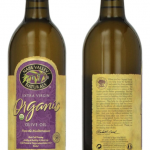
Napa Valley takes the idea of traditional and makes the best of it. The ruffles around the label give an aged aesthetic, while the gold color choice pops off the brown bottle exceptionally.
Selling More Olive Oil in Retail Stores
If you sell olive oil, having shelf space in retail stores is a must. Your goal should be to get on more shelves, to be in more stores, and to run promotions that give customers another reason to buy your bottle.
Wholesale Strategy: Getting on More Grocery Store Shelves
For retail stores to want to carry your olive oil, they want to be confident that it’ll sell.
When expanding retail presence, make your product presentable to help convince retailers to carry your product. Once you’ve secured shelf space in a single store, let the nearby shoppers know.
If locals buy your product from one store, other stores will have a good reason to carry your product as well. From there, it’s all about continued promotion and getting more shelf space.
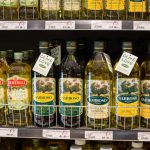
Being on more shelves in more stores is all about making contacts. Retailers and consumers alike need to hear your brand’s voice and what makes your brand a unique product, and the best option in the olive oil industry.
Retail Promotions
Promotions are an important part of increasing your retail store sales. Many stores have brands offering in-store samples, where you may be able to serve your olive oil with bread or a small salad.
Of course, there are also discounts. If customers can’t get a taste in the store, then the money is the second-best flavor. Bargain deals go a long way in the shopper’s eye-test.
Selling Olive Oil Online
Selling online is more than a recommendation. eCommerce has only gone up over the past few decades, and buying kitchen ingredients online has become a phenomenon.
Amazon is the go-to for many online shoppers, and selling on your own website is also a great way for customers to visit your ‘storefront’ directly and learn more about other products.
As for selling on your website, we recommend the following tips:
- Your eCommerce page should be mobile-friendly.
- It should be optimized for Google (SEO – Search Engine Optimization).
- It should be straightforward and easy to navigate.
Additionally, there are some interesting tactics that can work well especially for online commerce.
Imagine if your customer base purchased your olive oil on a monthly basis. Subscription-based sales are meant for the internet. Many olive oil shoppers keep a bottle in their cabinet year-round. Subscriptions are in right now, as several big grocery stores are even providing scheduled purchases.
You can give customers better deals with subscriptions while ensuring future purchases for your business.
Social Media Marketing for Olive Oil Businesses
A strong social media presence is necessary for a business in 2020. Consider these 5 tips to better help you market your olive oil business on social media:
- Post regularly! Consistent (but not spammy) posting keeps eyes drawn to your business.
- Plan your posts. Maintain a nice post-frequency with a calendar, and schedule your posts to go out at certain times.
- Use consistent branding & information across social media platforms.
- Link your profiles. Many folks are on more than one platform, so you should make it easy for them to find you on other sites.
- Get Creative. Whether it’s by running contests or giving cooking advice, the goal here is for users to see your brand as engaging and unique.
Marketing Olive Oil on Facebook
Over a billion people are active on Facebook, and with so many subcommunities, being on Facebook should be a priority.
Facebook is the best “About Me” page your business can have. It’s the perfect platform to tell the history of your brand — thus attracting people to your brand with a captivating and personable story.
Your brand’s story aside, you can use Facebook to market your olive oil business in a number of ways:
- Answer questions & interact with customers.
- Let people know about promotions and sales.
- Give users free recipes and cooking tips.
- Help people find the nearest retail store that carries your product.
- Link users to your brand’s website & other platforms.
Marketing Olive Oil on Instagram
Instagram is a visual medium, and your olive oil business should take advantage of that!
Instagram is a great place to showcase your olive oil in the most attractive photo you can capture. What’s more, you can use Instagram to show off your product in a video, giving potential customers a more personal idea of having your olive oil in their kitchen.
With cooking videos becoming ever-more popular, partnering with influencer chefs can be especially effective on Instagram. Having a popular Instagram chef show off your product can draw a large audience to your olive oil. This can be as simple as having them use your olive oil brand as one of the ingredients in a cooking video they create.
Driving Traffic to Your Olive Oil Business Website
Traffic is the keyword of the internet. And you want all of it. The two big ways to get people on your website are through paid advertising and tactics that generate organic traffic.
Paid Advertising on Google, Facebook, & Instagram
Paid advertising is a direct and quick way to increase the visibility of your website and social media pages.
Be sure to explore your ad-targeting options for Facebook, Instagram, Google, and other channels. And don’t forget to retarget. Shoppers who visit your website can be served ads later on, with messages that are specific to their previous experiences.
Having tools like a Facebook Pixel and Google Ads Tag installed help navigate the retargeting process. A Facebook Pixel works to track ad conversions and optimize ads, while a Google Ads Tag tracks ad conversions as well, and remarkets products on your website.
Generate Organic Traffic from Content
Organic traffic should be the main source of the traffic to your website. To generate more organic traffic, try out these recommendations:
- Email marketing: This may include website/social media content, new product updates, promotions, coupons, and brand newsletters.
- Blogs: The content should echo your brand’s message. Blogs might include free recipes and engaging video tutorials.
- SEO-Optimized Website: Every page on your site, and your website’s structure, should aim to rank well with Google.
You’re Ready to Grow Sales for Your Olive Oil Business
To say the olive oil market is competitive is an understatement. It takes distinct and consistent branding to stand above your competitors. However, by making a strong online presence and capitalizing on retail shelf space, your olive oil brand is surely able to navigate the industry.

